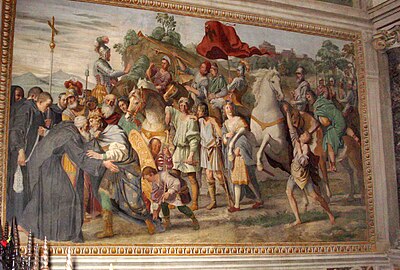
Otto III, Holy Roman Emperor, also called miribilia mundi, despite his short life (he died in 1002, at age 21), is a historical figure who attracts considerable scholarly attention as well as inspires numerous artistic and popular depictions.[2]
An intellectual emperor, even deemed a genius (although in older research, it was often pointed out that this genius leaned towards grandiose but unrealistic plans), Otto greatly developed the idea of empire with both novel and conventional conceptions during his reign.[3][4] His diplomatic activities coincided with and facilitated the Christianization and the spread of Latin culture in different parts of Europe.[5][6] His early death though made his reign "the tale of largely unrealized potential".[3][7][8] Controversies over the emperor, particularly his Renovation program, have remained hotly debated until this day. Lindsay Diggelmann notes that, "His brief life (980-1002) remains rather shadowy, even by the standards of medieval biography. Yet it has assumed an enormous importance in the history of German national consciousness, since many scholars have chosen to see Otto and his predecessors in the Saxon line as the founders of a German empire in the post-Carolingian period."[9]
Otto has a reputation of piety and association with contemporary saints and great intellectual figures, as well as romantic legends. The legend (now considered unlikely to be true) of the love between Otto and Stephania, the widow of Otto's relative and enemy Crescentius, as well as Otto's poisoning by her, is a particularly frequent subject of artistic depictions of the emperor.
- ^ Althoff 2010, p. 74.
- ^ Althoff 2010, p. 1.
- ^ a b Althoff 2010, pp. 11, 148.
- ^ Bryce, James (1866). The Holy Roman Empire. MacMillan and Company. p. 228. Retrieved 30 May 2022.
- ^ Bideleux, Robert; Jeffries, Ian (10 April 2006). A History of Eastern Europe: Crisis and Change. Routledge. p. 119. ISBN 978-1-134-71985-3. Retrieved 30 May 2022.
- ^ Lewis, Archibald Ross (1988). Nomads and Crusaders, A.D. 1000-1368. Georgetown University Press. p. 83. ISBN 978-0-253-34787-9. Retrieved 30 May 2022.
- ^ Emmerson, Richard K. (18 October 2013). Key Figures in Medieval Europe: An Encyclopedia. Routledge. p. 497. ISBN 978-1-136-77518-5. Retrieved 30 May 2022.
- ^ Muldoon, J. (19 August 1999). Empire and Order: The Concept of Empire, 800–1800. Springer. p. 35. ISBN 978-0-230-51223-8. Retrieved 30 May 2022.
- ^ Diggelmann, Lindsay (2005). "Otto III (review)". Parergon. 22 (1): 185–187. doi:10.1353/pgn.2005.0019. S2CID 144996570. Retrieved 18 March 2022.